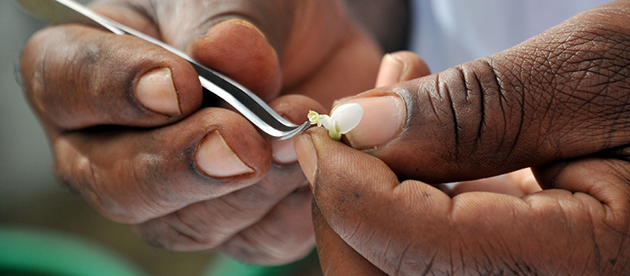Breeding
What if beans could be bred to resist pests and diseases, survive in periods of drought, thrive in low fertile soils, provide bumper yields, contain more zinc and iron, fetch a good price on the market, cook quicker and taste good?
They can be. And they are.
Since 1996, PABRA has released over 450 new bean varieties, all of which were bred to be more resilient, abundant, nutritious or marketable than their ancestors.

Breeding is a continual challenge. Pests and diseases evolve, weather patterns are becoming more unpredictable, and no one bean variety can meet the diverse market needs of a country or region.
The responsibility for addressing these challenges is shared amongst PABRA members with the support of CIAT, which conserves thousands of wild and domesticated bean varieties in its gene bank in Colombia. Together, we work to address specific traits to make beans more productive across the variable environments and markets of sub-Saharan Africa.
Our breeding priorities
Our breeding program focuses on five top priorities:
- Responsive to market demands, including dry, canned and niche market beans, such as snap, green and fresh grain
- Resistance to major abiotic constraints, including drought, heat, cold, water logging, and low soil fertility including acidity, low nitrogen, low phosphorus and salinity
- Resistance to major biotic constraints, including targeting new diseases and pests both in the field and post-harvest
- Cooking and nutritional quality, including higher Iron and Zinc content
- Higher yields
Our bean products
Breeding is organised into three major product groups, each aimed at addressing the five priorities:
- Niche market bean varieties: as a means of addressing rural poverty in Africa.
- Multiple stress resistant dry bean varieties: for household consumption and sale in local and regional markets.
- Micronutrient rich bean-varieties: to combat widespread micronutrient malnutrition in member countries. Bio fortification relies on conventional plant breeding and modern biotechnology.
Our regional breeding program
The capacity of our national research partners varies from one country to another, ranging from a single scientist working on a variety of legume crops to multi-disciplinary teams covering different disciplines, including breeding, and working on a single crop
As a result, and mirroring every other aspect of the way PABRA works, breeding is a collaborative process between PABRA, CIAT and the breeders working within national agricultural research stations (NARS). Together, we have a coordinated regional breeding program.
CIAT and national research stations that have breeding programs develop germplasm to address specific constraints. Responsibilities are agreed amongst PABRA members and based on regional research priorities.
The resulting germplasm is made available to the rest of the interested research programs within PABRA for evaluation, either through specific county requests or through regional evaluation nurseries and trials.
Variety selection
New bean varieties must go through stringent evaluation before they are released into the market. This can take up to 10 years depending on the number of crop cycles per year.
Tests are carried out by national research programme breeders both on-station, under controlled environments, as well as on-farm, using participatory variety selection processes to capture farmer and trader preferences.
It is only when there is proof of outstanding performance in productivity, resilience, nutrition, marketability and social acceptability that national research stations present the data to their country variety release committee, where required. Approved varieties are then registered on member country’s national variety list.
